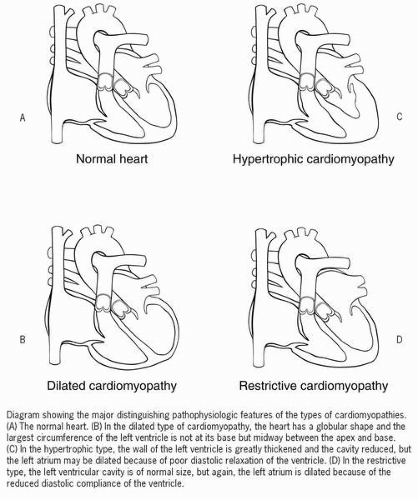Cardiomyopathies
Cardiomyopathy is a term used to describe a diverse group of cardiac diseases that primarily affect the structure and function of the myocardium and its pumping ability. Two major divisions of cardiomyopathy are ischemic and nonischemic. This chapter deals only with nonischemic cardiomyopathy.
Ischemic cardiomyopathy refers to the type of myocardial dysfunction that occurs in coronary artery disease (see Chapter 34). Nonischemic cardiomyopathies are classified into three groups—dilated, hypertrophic, and restrictive—based on their pathophysiological effects on the heart. Although some cardiomyopathies may be secondary to specific causes, most are idiopathic.
Dilated cardiomyopathy accounts for more than 90% of all cardiomyopathies and results in 20,000 deaths per year. It can occur at any age, but its peak incidence occurs in the fourth or fifth decade. African-American men have 2.5 times higher risk than whites and women. Half the cases of dilated cardiomyopathy are idiopathic, and the remainder can be attributable to a known cause. Certain chemotherapeutic agents, particularly doxorubicin and daunorubicin, cause serious myocardial damage.
A disproportionate number of individuals with dilated cardiomyopathy are alcoholics—approximately 4%—and this is the second leading cause of dilated cardiomyopathy. Damage may be due to direct toxic effects or to nutritional deficiencies. Dilated cardiomyopathy is now seen more frequently in cocaine abusers. Peripartum cardiomyopathy generally develops in the last month of pregnancy and up to 5 months postpartum. Another form of dilated cardiomyopathy may be the consequence of previous viral, bacterial, or parasitic infections. Autoimmune factors, thyrotoxicosis, diabetes, neuromuscular diseases, and hypersensitivity reactions to some medications have also been associated with cardiomyopathy.
Pathophysiology
Dilated cardiomyopathy is characterized by cardiomegaly due to ventricular dilation and by impaired myocardial contractility and mixed systolic and diastolic dysfunction, a condition in which poor systolic function (weakened muscle function) is further compromised by dilated ventricular walls that are unable to relax. A decreased ejection fraction and/or cardiac output, increased end-diastolic pressure with pulmonary congestion, and stasis of blood with mural thrombi are the result. The walls of the ventricle do not become
thickened as in congestive heart failure, which is thought to be due to diffuse inflammation and rapid degeneration of myocardial fibers and fibrosis. Deterioration is rapid after the onset of symptoms, and 20% to 50% of patients die within 1 year. Most deaths occur within 5 years.
thickened as in congestive heart failure, which is thought to be due to diffuse inflammation and rapid degeneration of myocardial fibers and fibrosis. Deterioration is rapid after the onset of symptoms, and 20% to 50% of patients die within 1 year. Most deaths occur within 5 years.
 Dilated cardiomyopathy is characterized by cardiomegaly due to ventricular dilation and by impaired myocardial contractility and mixed systolic and diastolic dysfunction, a condition in which poor systolic function (weakened muscle function) is further compromised by dilated ventricular walls that are unable to relax.
Dilated cardiomyopathy is characterized by cardiomegaly due to ventricular dilation and by impaired myocardial contractility and mixed systolic and diastolic dysfunction, a condition in which poor systolic function (weakened muscle function) is further compromised by dilated ventricular walls that are unable to relax.Stay updated, free articles. Join our Telegram channel

Full access? Get Clinical Tree


Get Clinical Tree app for offline access


